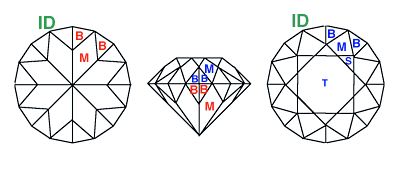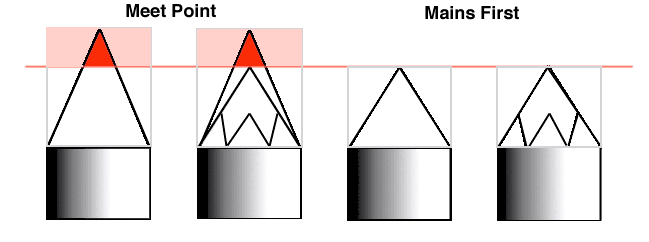Traditional Cutting vs. Meet Point Cutting
There are two ways to cut the same stone (actually there are a lot more than that), and each takes a different approach. A new faceter probably needs to know this as there are two types of Faceting Diagrams and they work a little differently. The older method uses diagrams like those in the Vargas book, and involve cutting the stone starting with the MAINs and then adding all the other facets. This means that you are often trying to match two points on the stone as you cut.
The newer method (called Meet Point) sets up instructions so that all facets are cut to one and only one point at a time. The idea is cut each successive round of facets so that there is only one point on the stone with which each must align.
There are pros and cons for each method. The positive aspect of the old method, is that there is less loss during the cutting process. Another way to look at it is that for the same size piece of rough, the older method, can produce a larger stone.
Meet Point faceting means more loss, but faster and easier cutting. You spend for less time nudging a newly forming facet to meet two points at the same time, and more time just watch one place move to another. I was taught on the first method, but have migrated to the second.
I still use the Vargas books, but have to translate the cutting diagrams to the meet point procedure. It is done like this.
Here are the typical Instructions for cutting as given in the Vargas books, This is for cutting a standard 57 facet round brilliant stone using a 32 index gear.

|
1.) |
Eight main facets (M) at culet angle, on eight fold asterisk settings. |
1.) |
Eight main facets (M) at Crown angle, on eight fold asterisk settings. Leave the correct amount of girdle at this step. |
|
|
2.) |
Sixteen break facets (B) at culet angle plus 2°, on settings adjacent to step 1 settings. The break facets reach slightly over one--half way from girdle to culet, and overlap slightly at the girdle. |
2.) |
Cut the table (T) at 0°, to where its width is about 60% of the stone width. |
|
|
3.) |
Sixteen girdle facets at 90°, on the step 2 settings. The main facets end up at a int on the girdle. |
3.) |
Eight star facets (S) at crown angle less 15°, on settings at midpoint of those in step 1. The star facets must each meet at the table. |
|
|
4.) |
Sixteen break facets (B) at the crown angle plus 3° to 8°, on the girdle settings. Each break must touch the star facet and pinch off the main to a point at the girdle. |
|||
|
P1.) |
Sixteen break facets (B) at culet angle plus 2°, on settings adjacent to ID settings. Cut all facets to a single culet point. |
C1.) |
Sixteen break facets (B) at the crown angle plus 3° to 8°, on the girdle settings. Each facet should align with a girdle facet. |
|
|
P2.) |
Sixteen girdle facets at 90°, on the step 1 settings. Level the girdle all the way around |
C2.) |
Eight main facets (M) at Crown angle, on eight fold asterisk settings. Cut till main just touches girdle. |
|
|
P3.) |
Eight main facets (M) at culet angle, on eight fold asterisk settings. Bring the top of facet just to girdle. |
C3.) |
Eight star facets (S) at crown angle less 15°, on settings at midpoint of those in step 3. Cut till tip just matches the break tip. |
|
|
C4.) |
Cut the table (T) at 0°, to meet C2 and C3 facets |
|||
Fundamentally you reverse the order of cuts on the pavilion facets. You cut breaks to a single point at the culet, then define the girdle, an finally cut the mains from the cult stopping at the girdle. The depth of the breaks is fixed by the the two cutting angles. If you wish a little more depth for the breaks, then subtract 1/2-1° from the mains.
The crown too is mostly reversed in cutting order. The meet point method provides a little less choice in placing the height of the break facets as their meet point is defined automatically when the mains are cut. Adjusting the mains culet angles will change the break facet height. (Its just a different way of thinking about their placement and position.)
By the way, there is more loss using this method is because the pavilion breaks are cut first. They must be brought to a point, and are at a higher angle than the mains. Because of he higher angle, the gem will be narrower than one created by cutting the mains first.

By cutting the breaks first the rough must be a bit longer as shown in the diagram. If the mains are cut first, then the final culet is establish immediately, and there is no further loss at the culet end. The two red areas represent the additional loses necessary with the meet point method, while maintaining all other proportions the same. It is not a lot but it does add up. I still prefer this method for the ease of cutting it introduces, and gladly give up the extra rough. (Not shown is a small additional loss at the girdle when using the Mains First method. It is negligible compared to the loss with the Meet Point method.)


